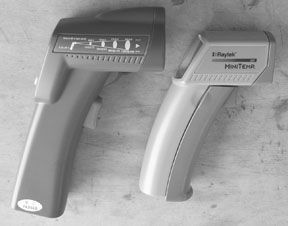
]Boat owners who do their own maintenance like to get as much help as possible diagnosing problems. One tool we’ve found helpful in this area is an infrared thermometer. These handy devices allow the user to measure the temperature of just about anything by simply pointing it at the object. You don’t actually have to touch the item, which is a nice feature to have when working on hot engines or electrical components.
An IR (infrared) thermometer can be used to find a dead cylinder on an operating engine—it would be cooler than all the others—or to check a pump bearing for overheating, or an HVAC duct for proper outflow temperature. Anything that varies in temperature can be monitored with an IR thermometer.
We looked at a pair of portable battery-powered units: one from Raytek, the MT4 Mini-Temp; and one from Telatemp, the High-Value IR Thermometer, model number 42529. Both are trigger-activated, pistol-grip units. Features common to both units include backlit LCD displays, laser sighting, and a 6:1 field of view, and both run on a 9-volt battery.
Laser sighting helps the user point the temp probe in the exact direction of the object being measured. Keep in mind that with a 6:1 field of view, the actual area where the temperature is being sensed is far larger than the laser sight would indicate. At 6 inches from a test surface, the probe is gathering data from an area 1″ in diameter. But, the farther the thermometer is moved away, the larger the sampling area becomes. For example, at 4 feet, the coverage area is 8″ in diameter.
Both units will have trouble getting accurate readings from highly polished or very shiny objects. In this case its best to apply a piece of electrical tape to the object, allow time for it to acclimate, and then measure the tape.

Our testing consisted of measuring the temperature of various items including walls, range tops, light bulbs, air conditioning vents, and one editor’s skin. All readings appeared consistent and accurate.
When you point an IR thermometer, at an object and pull the trigger, the temperature of the object is instantly displayed in the LCD window. Both of the units worked in this fashion. The Raytek’s LCD backlighting and laser pointing are automatically activated when the trigger is pressed. To change from Fahrenheit to centigrade on the Raytek, you open the handle and move a switch.
The Telatemp unit is larger and has four pushbuttons in plain view just below the LCD screen. The laser sighting and backlighting can be turned off or on as needed with a quick thumb press of clearly marked pushbuttons. This should aid in conserving battery power. Selecting Fahrenheit or centigrade is done by pushing another pair of buttons.
We like the compact size of the Raytek unit and its comfortable fit in the hand. However, we’d opt for the Telatemp unit because of its switchable laser, switchable backlighting, and slightly wider temperature-sensing range. Its lower price of $79 compared to the Raytek’s $99 also factored into our decision.
Contacts
• Raytek, 800/866-5478, www.raytek.com
• Telatemp, 800/321-5160, www.telatemp.com


































